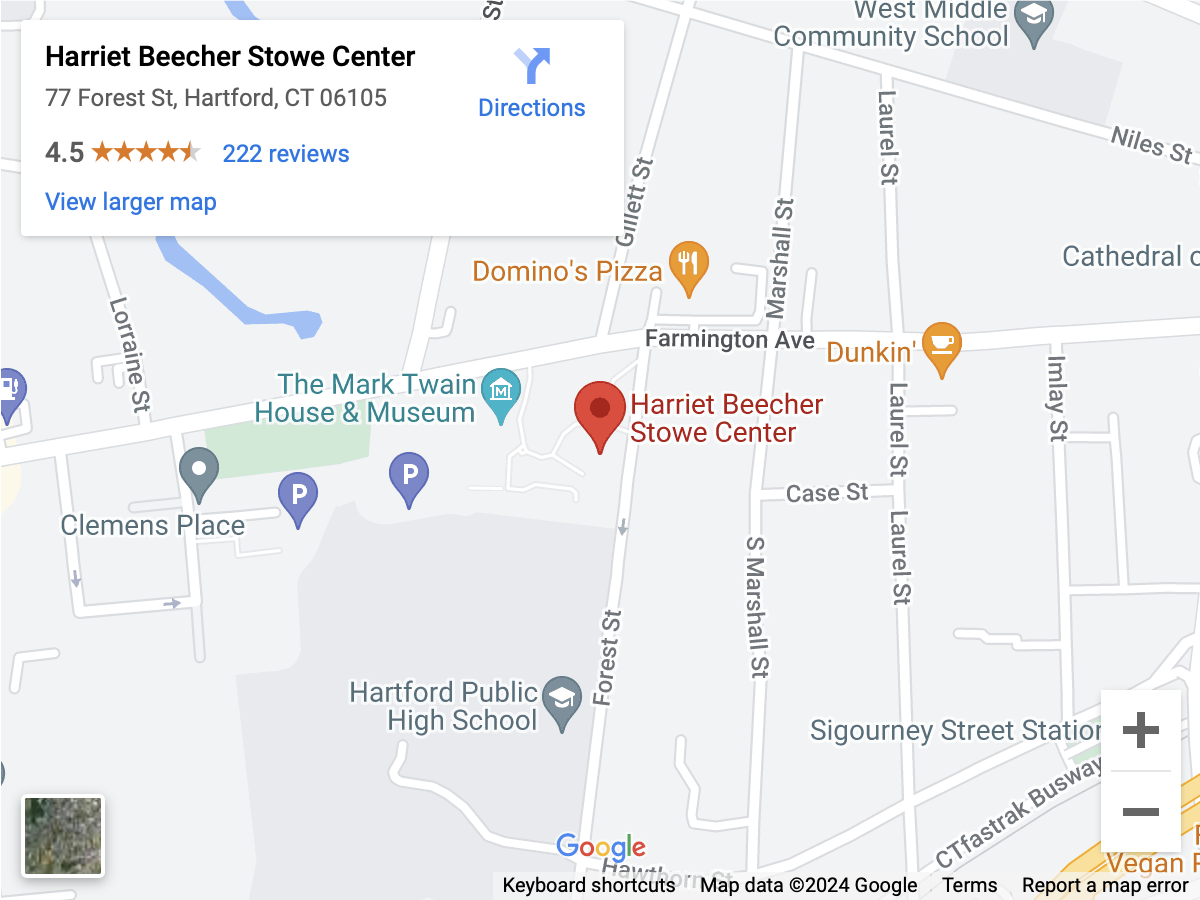Walk in the footsteps of Harriet Beecher Stowe, internationally famous author of anti-slavery novel Uncle Tom’s Cabin. Her 1871 home — now a National Historic Landmark — reflects Stowe’s Victorian decorating choices and includes modern galleries and interactive spaces connecting Stowe’s work to the present.
Freshly restored in 2017, Hartford’s Stowe House is the place to learn about Stowe’s life and work and the worldwide impact of Uncle Tom’s Cabin.
The Stowe House Experience, with conversations connecting the past to present social issues, will leave you inspired, like Stowe, to use your words to change the world.

The Harriet Beecher Stowe House was commissioned in 1871 as a spec house by Franklin Chamberlin, a wealthy Hartford lawyer. The design likely comes from a published plan. Stowe purchased the property in 1873, and in May of that year, moved in with her husband and adult twin daughters. The family remained there for the last 23 years of Stowe’s life.
After Stowe’s death in 1896 at the age of 85, the house passed out of family hands until 1924, when it was purchased by Stowe’s grand-niece, Katharine Seymour Day. Day lived in the Stowe house from 1927 until her death in 1964. During those years, Day collected manuscripts and objects connected to her famous aunt, Uncle Tom’s Cabin, and the house’s Hartford neighborhood, Nook Farm. In 1968, after extensive renovation, the Harriet Beecher Stowe House opened to the public as a museum.
In 2016/2017, the Harriet Beecher Stowe House underwent its first major interior renovation in nearly 50 years. Updates include a modern climate control system, state-of-the-art fire suppression, restored windows, and refreshed historic finishes inspired by Stowe.
Make the Stowe Visitor Center your first stop when you arrive on campus. Here you can purchase tickets for the Stowe House Experience and explore resources for taking action on social issues that matter to you.
Allow time to shop in the Museum Shop located inside the Visitor Center. You’ll find social justice influenced souvenir!
Your purchases support programs and preservation.
The 1873 Visitor Center was once the carriage house for the Katharine Seymour Day House.
For hours of operation, click here.
Katharine Seymour Day (1870-1964) was Harriet Beecher Stowe’s grandniece. An ardent preservationist and activist, Day founded the Harriet Beecher Stowe Center in 1941. That same year she purchased the gilded age mansion adjacent to the Stowe House to save it from demolition.
Now named in her honor, the Katharine Seymour Day House holds the Stowe Center Research Library, administrative offices, and collections storage. It is periodically open to the public for exhibits, programs, and tours.
Katharine Seymour Day House History
The 1884 structure, built in the Queen Anne or Aesthetic style, was designed by architect Francis H. Kimball for Franklin and Mary Chamberlin. Kimball was later a successful commercial architect in New York.
The wood and granite exterior features an eclectic mix of turned balusters and porches, a variety of windows, and multiple balconies. The original exterior paint scheme, roof shingles, crestings, and finials were restored in 2002.
The Stowe Center Research Library offers access to a significant and substantial collection of material related to the Beecher and Stowe extended families, members of the culturally significant Hartford, CT Nook Farm neighborhood, and Harriet Beecher Stowe’s groundbreaking novel Uncle Tom’s Cabin.
Collections include more than 12,000 books, 4,000 pamphlets, and 180,000 manuscripts, as well as 12,000 images – photographs, prints, broadsides, posters and drawings.
The Library is open by appointment only from 9:30 AM to 4:30 PM, Monday through Friday. To schedule, contact the Director of Collections and Research at 860.522.9258 x313 or Research@StoweCenter.org

Stowe was an enthusiastic gardener, creating and tending flower and vegetable gardens at all of her homes and publishing numerous gardening articles and poems.
Inspired by her writing, the Stowe Center gardens feature shade-loving perennials, colorful annuals, shrubs, meadow flowers, exotic elephant ears, castor bean plants and stately roses, with color from April through September.
The gardens include Connecticut’s largest Merrill Magnolia; grafts from The Stowe Dogwood, a pink variety believed to be from Stowe’s time; a National Champion Tree, the Common Paw Paw; and The Garden Club of America award-winning heritage roses.
Part of Connecticut’s Historic Gardens.
Learn more about Stowe’s Gardens here.
19th century Nook Farm was home to writers, politicians, reformers, and activists.
Two residents, Harriet Beecher Stowe and Mark Twain, were international celebrities. Others included Isabella Beecher Hooker, Stowe’s sister and women’s rights activist; Charles Dudley Warner, author; and William Gillette, actor and playwright.
Today, several 19th-century buildings remain including the homes of Harriet Beecher Stowe and Mark Twain. 
The Mark Twain House & Museum is located next door to the Harriet Beecher Stowe Center. A National Historic Landmark, the Twain House was the home to author Samuel Clemens (a.k.a. Mark Twain) and his family from 1874 to 1891.
See two National Historic Landmarks in one day: The Twain House offers public tours, school programs, and special events. More information: MarkTwainHouse.org

 Thank you for your generous gift! A welcome letter and your membership card(s) will be mailed to you shortly.
Thank you for your generous gift! A welcome letter and your membership card(s) will be mailed to you shortly.